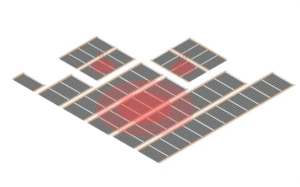Table of Contents
ToggleGraphene Electric Heating Film Misconception 1: Ready to use will save energy
Some people turn on the underfloor heating system when the room needs to be heated and turn it off when they go out, thinking that this will save electricity. In fact, this not only does not save electricity but also consumes electricity. The graphene electric heating film is a low-temperature heating system, and the heating film is buried in the cement layer or underground floor. Therefore, the underfloor heating system has good heat storage performance. In this case, the performance of underfloor heating has a lag. That is to say, it takes a certain time to turn on the system to make the room temperature reach the set temperature, and after turning off the system, the room temperature will not rapidly decrease. It takes a long time for the temperature to decrease. Frequent switching not only does not have an energy-saving effect but also increases the operating cost of underfloor heating and reduces its service life.
The correct approach is:
Unused rooms can be cooled down by a few degrees. When leaving for a long time, the temperature only needs to be lowered, and the system can only be turned off when there are no occupants or when leaving for a long time.

Graphene Electric Heating Film Misconception 2: Setting high temperature to increase quickly
Some users feel that the room temperature is low and need to quickly increase the temperature, so they set the thermostat temperature to the highest, which is also a wrong approach. The heating time of a room depends on the temperature difference between indoors and outdoors, the installed power per unit area of the room, and the insulation condition of the house. In the case where the installation power and outdoor temperature difference are constant, no matter how much temperature you set the thermostat to, it will always take some time for the room to reach the temperature you need. In this case, setting the temperature of the thermostat to 18 degrees and 25 degrees will take the same amount of time to heat up.
The correct approach is:
Set as many degrees as needed. Nowadays, temperature controllers are all smart controllers, as long as the opening time and temperature are set in advance.
Graphene Electric Heating Film Misconception 3: All thermostats are the same
Many users set the temperature according to their own needs, but after setting the temperature, they cannot achieve the desired heating effect. There are two situations: one is that the temperature controller is not set correctly, because there are multiple types of temperature control, including room temperature type, ground temperature type, and dual temperature type. The dual temperature type can also choose different modes. Some underfloor heating systems have low temperature settings, and the low temperature is quickly reached, but the room temperature has not yet reached the set temperature, so some people may say that underfloor heating is not hot and the effect is not good.
Another issue is that the set temperature is the same, but the temperature in each room feels different, which is related to the location of the room temperature controller. If the temperature controller is installed near doors, windows, exterior walls, or other places with high heat dissipation, although the displayed temperature is not high, the room temperature is already very warm. This can be set according to the specific actual situation to avoid unnecessary waste.
The correct approach is:
According to different models of thermostats, the required temperature should be set. The correct use of the temperature control system is also an important factor in the energy-saving of the underfloor heating system. In addition, relevant regulations should be followed during use to avoid affecting the effectiveness of underfloor heating due to incorrect use.
Graphene Electric Heating Film
Common problem handling methods and precautions (Graphene Electric Heating Film)
1. Before installing graphene heating film, it should be confirmed that the power supply line and meter capacity can support the system’s electricity load. For those with insufficient capacity, the first step should be to increase the capacity to meet the system’s electricity needs.
For newly built or renovated residential buildings, after the system installation is completed and the ground decoration is finished, it is necessary to wait for the ground to dry naturally (about 28 days) before heating. When decorating the ground, pay attention to avoiding the electric heating film to avoid damaging the system.
3. In order to ensure that heat is fully utilized, the most ideal floor decoration materials are stone, imitation stone, or ceramic tiles. These materials have good thermal conductivity and can not only enjoy warmth in winter, but also lower indoor temperature in summer. Next are waterproof and heat-resistant composite flooring and bamboo flooring, as these types of flooring also have good thermal conductivity. If solid wood flooring is used to pave the ground, high-quality flooring materials must be carefully selected. Firstly, the moisture content of the flooring should be less than 8%. Secondly, the surface of the floor, including the back and cross-section, should be treated with waterproofing to prevent moisture and expansion, and to prevent cracking when exposed to heat. Thirdly, the surface temperature should not exceed 28 degrees (the ground design temperature is generally between 24-30 degrees), otherwise it will cause deformation of the floor. At present, multiple manufacturers in China have produced solid wood flooring specifically for geothermal use, meeting the needs of a large number of underfloor heating users.
4. Strictly prohibit the use of keel as a cushion layer for floor paving to prevent iron nails from damaging the electric heating film and causing electrical leakage.
5. It is best to choose furniture with a bottom that is at least 10 centimeters away from the ground to ensure heat dissipation and avoid damaging furniture due to geothermal heat.
6. When starting the system for the first time, the initial heating rate is slow, taking at least 3 hours. If the ground thermal storage protection layer is thick, it can take up to 12 hours; In addition, there is a building structure heat storage process, which usually lasts for about a week. During this period, it is best not to lower the heating temperature or shut down the system. During the heat storage period, the operating costs will be higher, especially for new buildings that are put into use in the first year and completed before the heating season. Due to the high moisture content in the building structure and the fact that they have not yet dried, the power consumption is relatively high within two weeks of starting heating. The operating costs on the first day can reach more than five times the normal operating costs, and then gradually decrease day by day. After the building dries, the operating costs tend to be normal. If the room is not in use at this time, the temperature can be adjusted to 5-10 ℃.
7. When using heating for the first time, set the temperature to a lower temperature (3-5 ℃ above the base temperature). After the system runs for a period of time, slowly increase the temperature until you feel comfortable.
8. When going out for a long time, be careful not to completely shut down the system in rooms with water supply and drainage, such as bathrooms and kitchens. The room temperature should be set at around 5 ℃ to prevent water pipes from freezing and cracking.

